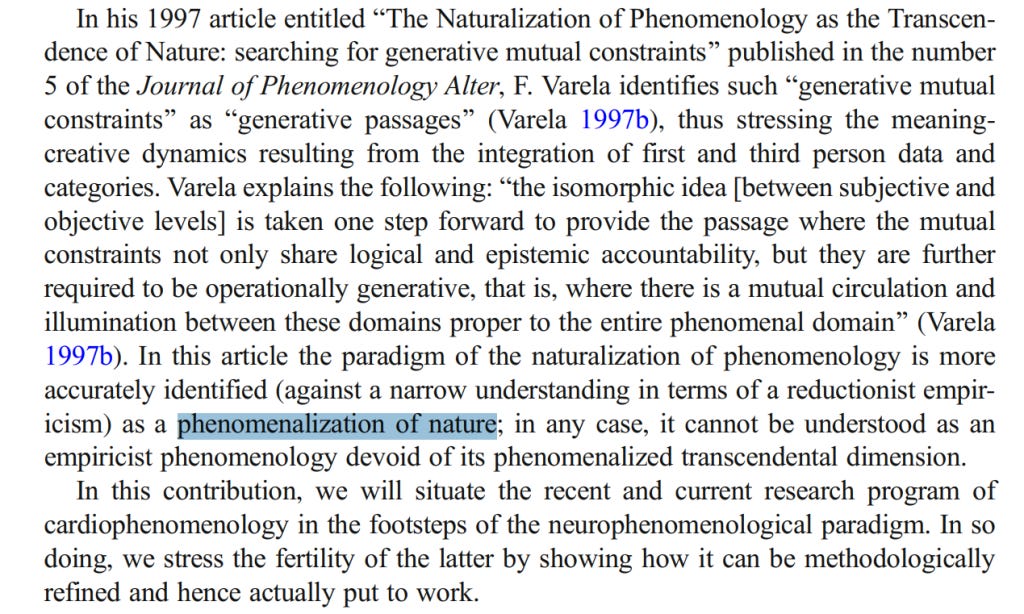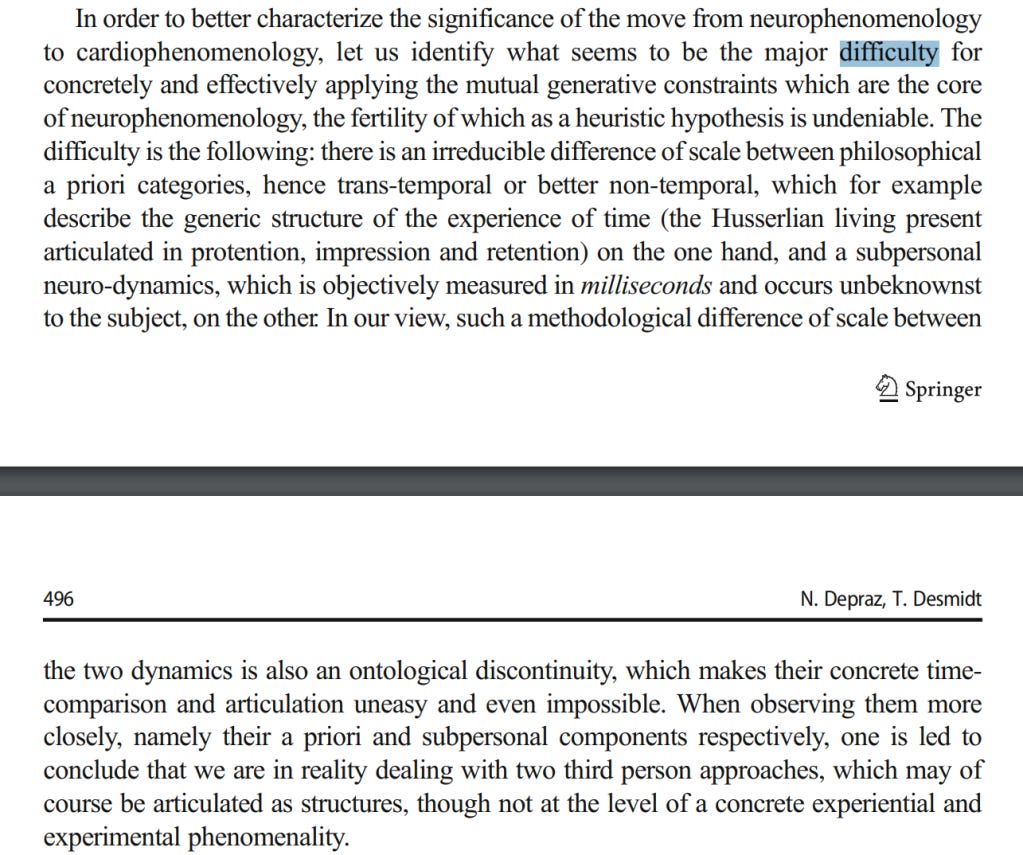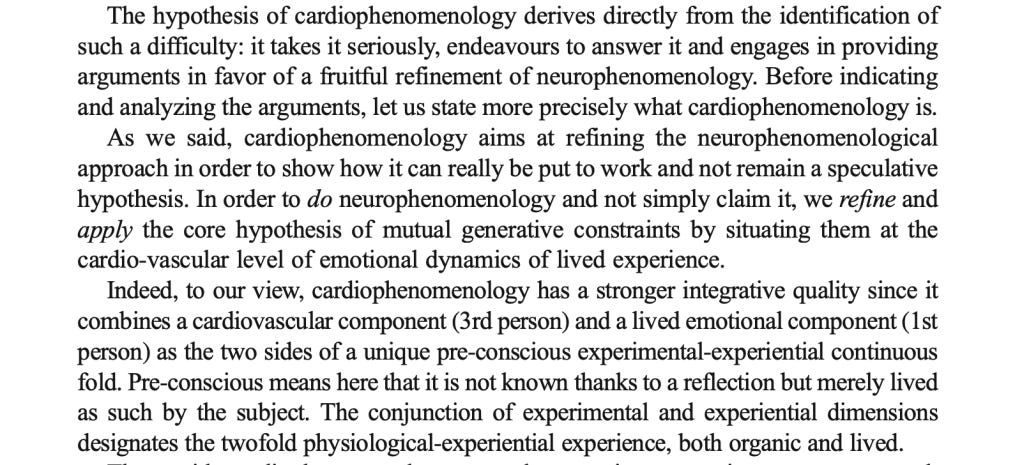Naturalization of phenomenology, Phenomenalization of nature - Part 1: “The Difficulty” of Mutual Constraints
An ongoing series in discussing critical concepts from the Cognition Futures reading group.
Depraz and Desmidt: “In order to do neurophenomenology and not simply claim it, we refine and apply the core hypothesis of mutual generative constraints by situating them at the cardio-vascular level of emotional dynamics of lived experience.”
An ongoing series in discussing critical concepts from our reading group.
Following the 55th meeting of the Cognition Futures Reading Group (CFRG), which is hosted by Orthogonal Research and Education Lab, I am full of thoughts about the paper we discussed and its relation to both our Methods Project, and the general endeavor of The Cognitive Science field, in and of itself.
Natalie Depraz and Thomas Desmidt coauthored “Cardiophenomenology: a refinement of neurophenomenology“, which articulately captures a path of development for what might be called (Francisco) Varela’s Quest: Varela (and his collaborators) have sought to more thoroughly make subjective, first personal experience something which could be more rigorously studied. Depraz, alongside Pierre Vermersch and Varela, created “On Becoming Aware“, as an exploratory record of their work on making explicit the nature or practice of one’s internal life and lived experiences (you could say “mental life”, as it is written on the publisher’s description, but it gives me some pause.)
Methodological shortcomings in cognition studies are indeed a Grand Question — or question set — with a core matter of how to relate what is centered within an agents internal experience, and what is “outside” of the agent as related to its environmental interaction. In recent meetings of the CFRG, for example, we’ve discussed Vicente Raja’s “A theory of Resonance: Towards an Ecological Cognitive Architecture“; wherein Raja attempts to link dynamical systems theory and Michael Anderson’s neural reuse framework as a means to built out an “ecological cognitive architecture”, or, a means of pairing the nervous system with the tenants of ecological psychology. The references in this paper are particularly of note.
“The isomorphic idea”, is a phrase of note. Should be “the isomorphic ideal?” Similarly, in a future post, I would like to investigate the remark of being against reductionist empiricism, including, perhaps, what that entails for phenomenological assertions for embodiment(s) and ethics.
As for the Varela (neuro)phenomenology research lineage, Depraz’s work in developing cardiophenomenology provides a useful context for the challenges of advancing phenomenology. Mutual constraints “not only share logical and epistemic accountability”, but would necessitate operational generativity, which“indicates the reciprocal productivity between first person and third person data/categories, which are modified, that is, at once enriched and limited according to an inter-active double move.”
Depraz and Desmidt go on to specify even further with generative mutual constraints: “In order to do neurophenomenology and not simply claim it, we refine and apply the core hypothesis of mutual generative constraints by situating them at the cardio-vascular level of emotional dynamics of lived experience.”
Why is this significant? In their abstract, they frame their arguments:
Here we present five main arguments for the necessary inclusion of the bodily-emotional heartsystem in the cognitive system: first, two pragmatic operational arguments (experiential and methodological), then three theoretical ones (cognitive, homological and ontological-laden).
At the core of the challenges of phenomenology, and perhaps the entire cognitive science endeavor, remains developing better methods and theories that can relate the multifaceted nature of experience of an agent. There are many questions about where the boundary lines (should) be demarcated: in terms of functionality, in terms of observable behavior, and particularly in terms of theoretical integrations — for a significantly abridged list. (For a much larger list, there may be a forthcoming post). Many interesting ideas, such as “resonance” (Thomas Fuchs, among others), would do well with methodological and theoretical advancement — but what form would that take? One approach is through sorting out “mutually informed constraints”, or, how observable 1P experiences can be tied to 3P experiences, and vice versa.
The authors offer two key moves in their work to these ends:
Asserting the cognitive system should include other arenas of bodily experience and intra/interaction, in this case, the cardiovascular system. (“The move from neurphenomenology to cardiophenomenology”)
Identifying a major difficulty in applying mutual constraints: the different timescales at play for both bodily processes at play which may drive or affect cognitive activity, and the cognitive perception, mitigation, or experience of such non-voluntary actions
The authors elaborate:
‘An ontological discontinuity which makes concrete time-comparison and articulation uneasy and even impossible.’ The authors even suggest that they may be dealing with ‘two’ 3P approaches; but their solution is in identifying a more appropriate means of coupling 1P & 3P. A claim is made that in order to make neurphenomenological tenants more tenable — in particularly, as we have no significant 1P experience of neuronal activity — that other, more applied arenas, may provide fruitful. In this case, that arena is the relation between the activity of heart (and thereby respiration), and the more subjectively-accessible affective signals coupled to cardiac variability.
Consider the difference between what you “feel” internally in terms of neural activity compared to your breathing, pulse, or heart-rate, when racing through an airport, or recalling childhood memories? One is an intensely athletic experience that overtly taxes the cardiovascular system, yet the other, even being “more mental”, doesn’t necessarily offer much in the way of feeling or sensing how your neurons fire. There are a variety of reasons for this — including the timescale differences as noted by the authors, and evolutionary costs and benefits towards what we can have affective, interoceptive, or otherwise intra-personal feedback about; at what level, and what timescale, and what behavioral or functional impact should something become relevant?
It’s worth noting that neuronal activity may be more subjectively tenable than the authors suggest — although perhaps not for Homo sapiens. There has been discussion in our group about what tools would assist or afford some kind of capacity for neuronal affectivity. The realm of advance brain-computer interfacing, and even more consumer-available health technology, may be a space to watch for such. But in the short term, the authors evoke questions about what arenas can provide enough affectivity for 1P experiences to substantially inform, and thereby offer operative (or generative) constraints, on 3P data?
A related question may be, what other aspects of embodiment may be available to integrate into the “applied neurophenomology” space; that is, if cardio-phenomenology is one approach into that arena, what other “____-phenomenology” applications may be tenable to investigate?
Ahead on our reading list is a paper about “microphenomenology” — which may be similar to “microeconomics”, in terms of individual or discrete, unitary phenomenological scenes. But I particularly appreciate the explication of the challenges at hand by Depraz and Desmidt — even in so much as articulating a severe difficulty and suggesting a methodological approach by which to attempt to glean useful insight.
PS: Via further discussion in the CFRG, another note: what is the relationship between affectivity and (self-directed) control? Thomas Fuchs describes basal affectivity, and builds up a case for emotions as offering directive or control-exerting information (driving towards some other state.) How can all of these fit together, within the concept of resonance, or other means of coupling 1P and 3P feedback?




